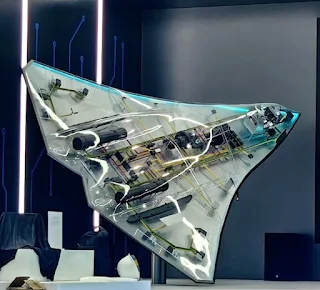China's 6th Generation Fighter Jet Maiden Flight: Redefining Aerial Dominance
 |
| China’s 6th-generation stealth fighter jet |
The aviation world is abuzz with excitement and speculation as China’s sixth-generation fighter jet successfully completes its maiden flight. This groundbreaking achievement marks a pivotal moment in the evolution of military aviation, signaling China’s ambition to redefine aerial combat and assert dominance in global defense technology.
In this article, we will delve into the features of this cutting-edge aircraft, compare it with global counterparts, and explore the strategic implications of its development. From advanced stealth and AI integration to next-generation electronic warfare capabilities, China's latest aerospace innovation underscores its position as a formidable contender in the international arms race.
The Maiden Flight: A Monumental Leap in Aerospace Technology
 | |
|
China’s sixth-generation fighter jet’s maiden flight is not just an incremental step forward; it represents a quantum leap in defense capabilities. The sleek, futuristic design and reported three-engine configuration have sparked widespread interest among defense analysts and enthusiasts worldwide.
Advanced Features
Next-Generation Stealth: The fighter jet’s stealth technology reportedly makes it nearly invisible to radar systems, providing a significant edge in contested airspaces.
Artificial Intelligence (AI): Integrated AI systems offer real-time combat analysis, task automation, and enhanced pilot support, ensuring superior decision-making during complex missions.
Electronic Warfare Capabilities: This aircraft is designed to disrupt enemy communications and disable sensor networks, solidifying its dominance in modern air combat scenarios.
Three-Engine Configuration: If reports are accurate, the unique engine setup could deliver unparalleled thrust and maneuverability, offering an edge in both high-speed engagements and dogfights.
The Competitive Landscape: How Does It Stack Up?
 | |
|
The sixth-generation fighter’s unveiling comes as the United States accelerates its Next-Generation Air Dominance (NGAD) program. Both nations are vying for supremacy in aerospace technology, but key differences in their approaches are emerging.
United States' NGAD Program
The U.S. NGAD initiative aims to develop a networked ecosystem of manned fighters, unmanned drones, and advanced surveillance tools, all seamlessly integrated with AI. Operational readiness is targeted for the 2030s, emphasizing interoperability and network-centric warfare.
China's Strategic Edge
China’s strategy appears more focused on raw performance, emphasizing speed, maneuverability, and multi-role functionality. If operationalized sooner than the U.S. program, China’s sixth-generation fighter could disrupt the balance of power in global aerial combat.
Key Innovations Driving China's Sixth-Generation Fighter Jet
China’s rapid advancements in aerospace technology are underpinned by several groundbreaking innovations. Here’s a closer look at the features that set this fighter jet apart:
Stealth Technology
Incorporates advanced materials and coatings to minimize radar cross-section.
Enhanced design reduces heat signatures and visual detection.
AI-Powered Systems
Automates routine tasks, freeing pilots to focus on strategic decision-making.
Real-time combat scenario analysis and coordination with unmanned drones.
Electronic Warfare (EW)
Capable of jamming enemy radar and communications.
Advanced sensors detect and neutralize threats in contested airspaces.
Drone Integration
Operates seamlessly with unmanned aerial systems (UAS).
Expands mission versatility, from reconnaissance to combat.
Strategic Implications: Shifting Global Power Dynamics
 |
| India and China |
China’s sixth-generation fighter jet represents more than just a technological marvel; it’s a strategic declaration of intent. As tensions rise in the Asia-Pacific region, this development could alter the geopolitical landscape.
A New Technological Arms Race
The successful maiden flight signals a new phase in the ongoing arms race between global superpowers. By accelerating its timeline, China demonstrates an ability to innovate, test, and deploy at an unprecedented pace, challenging U.S. dominance in the process.
Implications for Asia-Pacific Security
China’s advancements come amid heightened tensions in the Asia-Pacific. The operational deployment of this aircraft could:
Enhance China’s ability to assert dominance in disputed territories.
Strengthen its deterrence posture against regional adversaries.
Pressure neighboring nations to enhance their defense capabilities.
Historical Context: Lessons from Past Conflicts
Cold War Arms Race
The U.S.-Soviet arms race set a precedent for rapid technological advancements.
China’s current strategy mirrors the competitive drive to outpace rivals.
Modern Manufacturing and R&D
Leveraging its manufacturing efficiency, China can fast-track development timelines.
Investments in research and development (R&D) ensure cutting-edge innovations.
Project Nanmen: The Backbone of China’s Aerial Strategy
China’s sixth-generation fighter jet is part of the broader “Project Nanmen” initiative, which aims to create a cohesive aerial combat network. By integrating advanced aircraft with drones and surveillance systems, Project Nanmen underscores China’s ambition to dominate contested airspaces.
Objectives of Project Nanmen
Establish a comprehensive aerial defense network.
Leverage AI and electronic warfare to disrupt adversarial operations.
Ensure interoperability between manned and unmanned platforms.
 |
| India Vs China |
Future Outlook: What Lies Ahead?
Operational Deployment
China’s accelerated timeline suggests deployment could occur well before 2030.
Countermeasures by Global Powers
The U.S. and its allies are likely to expedite their defense programs.
Enhanced focus on counter-stealth technologies and electronic warfare.
Evolving Combat Scenarios
Integration of AI and drones will redefine traditional notions of air combat.
Multinational exercises to simulate next-generation warfare environments.
Conclusion
China’s sixth-generation fighter jet is not merely a technological achievement; it’s a statement of intent. By integrating stealth, AI, and electronic warfare capabilities, this aircraft is set to challenge existing paradigms of air dominance.
As the race for technological superiority intensifies, the global defense landscape is poised for a seismic shift. The world will be watching closely as China continues to push the boundaries of aerospace innovation, reshaping the future of aerial combat.
What are your thoughts on China’s sixth-generation fighter jet? Join the conversation and share your views below!
.jpg)


Comments
Post a Comment